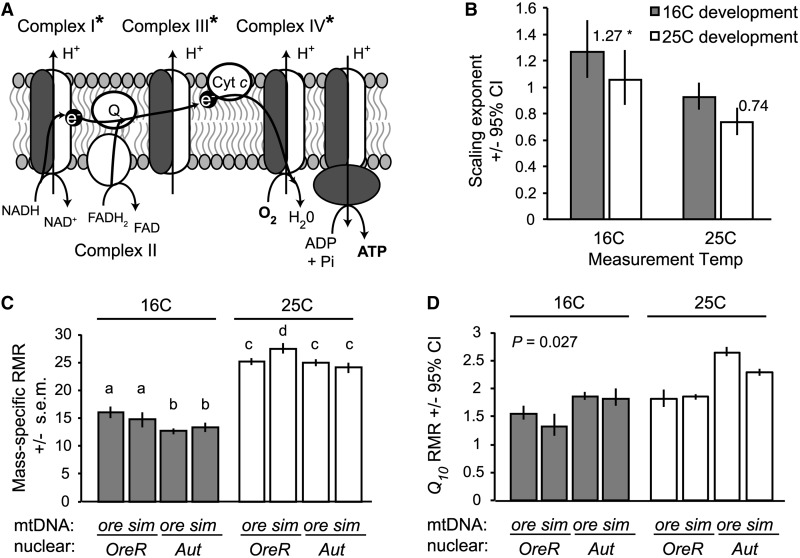Fig. 3.
Genetic and environmental effects on metabolic scaling, mass-specific RMR, and metabolic plasticity in D. melanogaster larvae. (A) Production of ATP via OXPHOS requires interactions between gene products encoded in the nuclear genome and in the mtDNA. A specific mitochondrial-nuclear genotype disrupts protein synthesis in the mitochondria and decreases activity for the three complexes in the electron transport chain that require proteins from both genomes (indicated by an asterisk; ATP synthase activity was not measured in this study) (Meiklejohn et al. 2013). (B) Larvae of different mitochondrial-nuclear genotypes had similar metabolic scaling exponents, but the scaling of RMR with mass was affected both by the temperature experienced during development and by the temperature at which the larvae were measured. Flies developed and measured at 16°C had a scaling exponent that was significantly >1 (P < 0.05), whereas flies developed and measured at 25°C had a scaling exponent that was not significantly different from 0.75 (P > 0.05). (C) When developed and measured at 16°C, larvae with different nuclear genomes had significantly different scaling coefficients, indicating different mass-specific RMR. However, when developed and measured at 25°C, the mitochondrial-nuclear genotype that compromises OXPHOS capacity shows a significantly elevated mass-specific RMR. Letters within temperatures indicate significant differences between genotypes (P < 0.05, type II regression analysis). (D) Mitochondrial-nuclear genotype also affects the Q10 of RMR (i.e., metabolic plasticity), and this effect depends upon the temperature during development, as indicated by a significant interaction between mtDNA, nuclear genome, temperature during development, and temperature during measurement (P = 0.027). Data are RMRs from 20 replicate pools of 5 third-instar, pre-wandering larvae per genotype and temperature treatment, as described in Hoekstra et al. (2013).

